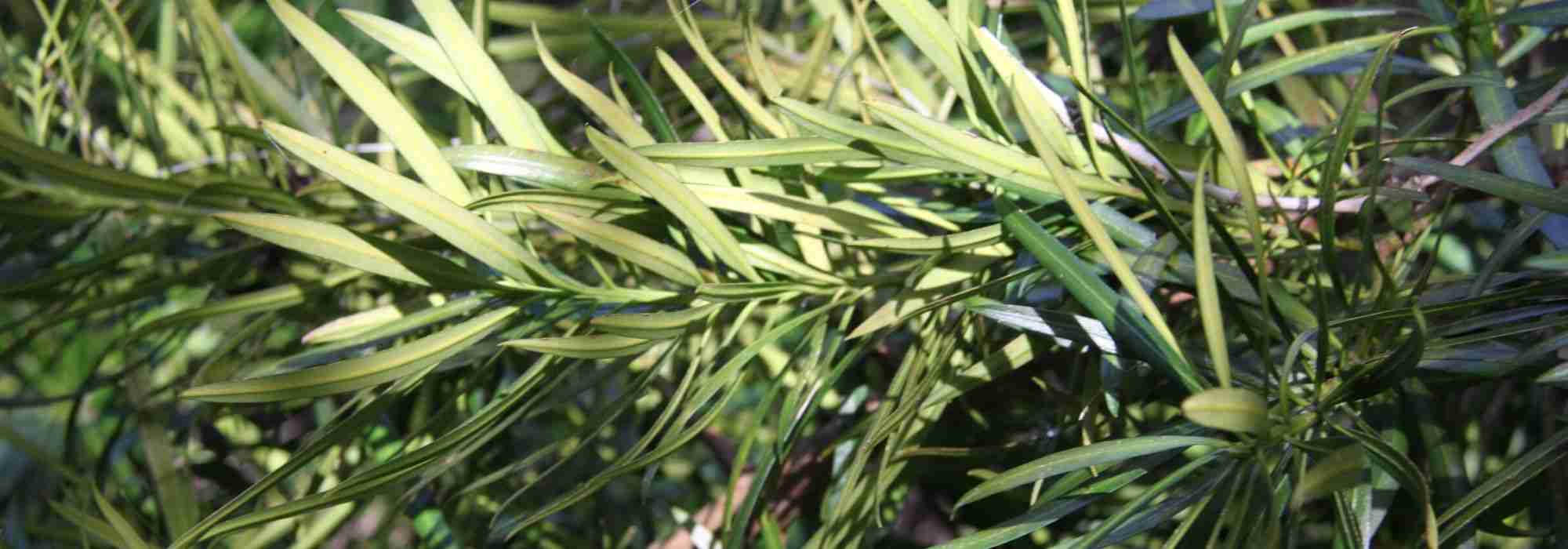
Podocarpus: planting, pruning, and care
Contents
Podocarpus, in a nutshell
- Podocarpus are quite rare conifers that form bushy groundcovers or upright trees that can be grown in pots, and even trained as bonsai.
- These plants thrive in oceanic climates, well-drained and relatively cool soils, but they do not tolerate harsh winters, wind, or drought well.
- Podocarpus macrophyllus, with its large, glossy green needles arranged in rosettes, will add an exotic touch to your terraces, while the low-growing species are suitable for rockeries, even in sunny spots, to cover a slope or a low wall, or as groundcover beneath other plants.
A word from our expert
Podocarpus are somewhat unusual evergreen conifers that are rarely found in amateur gardens. However, the species Podocarpus macrophyllus, also known as Buddhist Pine, is often offered as a bonsai because it adapts well to the atmosphere of a home, in a bright spot protected from direct sunlight, with regular watering. The plant can be placed outside, sheltered from frost and full sun. This species, native to the mountains of Japan and China, is frequently planted around temples. It is quite hardy (-10 to -15°C), has a relatively fast growth rate, and thrives in rich, cool soil, and is even used to form trimmed hedges. Its upright and dense silhouette is appreciated, often enhanced by cloud pruning and growing it in a large pot.
There are also prostrate Podocarpus, such as Podocarpus lawrencii ‘Blue Gem’, which is native to Australia and tolerates drought and frost better. These trees exhibit a wide range of requirements depending on the species, from cool and humid climates to warm and humid ones, with exposure from full sun to shade, and soil that can be rich and cool or poor and relatively dry. Their hardiness rarely exceeds -15°C, so they generally prefer warm temperate or tropical climates.
These plants, highly ornamental for their foliage and shape, can, however, be disappointing and grow very slowly if they do not receive optimal conditions.
Description and botany
Botanical data
- Latin name Podocarpus
- Family Podocarpaceae
- Common name podocarp, totara, buddhist pine
- Height between 1.5 and 6 m
- Exposure variable depending on the species
- Soil type any loose, well-drained soil, with variable fertility and moisture depending on the species
- Hardiness Average (-10 to -15 °C)
The genus Podocarpus refers to somewhat special conifers, closely related to yews (Taxus) in terms of needle appearance, which can be much broader, as well as in the fruit structure that has a fleshy part, the aril, partially covering the seed. With around a hundred species mainly found in South America and Indonesia, Podocarpus is the principal genus of the Podocarpaceae family alongside Dacrydium and Lagarostrobos, better known as Huon Pine. Two species are native to the Northern Hemisphere, including Podocarpus macrophyllus, which originates from the southern mountains of China, Taiwan, and Japan.
These plants exhibit a very varied habit, ranging from the erect or columnar tree reaching 50 m in height, such as Podocarpus elatus, to the prostrate shrub, a groundcover limited to 1 m in height, including massive, spreading weeping forms like Podocarpus salignus from Chile. Their dense appearance, with dark green evergreen foliage, gives them an exotic or even Japanese look when pruned into cloud shapes, especially in potted specimens (bonsai or others) like the Buddhist Pine (Podocarpus macrophyllus). Some resemble broadleaf trees such as the species Podocarpus salignus (with willow-like leaves), neriifolium (with oleander-like leaves), or falcatum (with sickle-shaped leaves), while others resemble small conifers like Podocarpus lawrencii, native to Australia, with its olive green, short, narrow needles arranged in a brush around short branches. The leaves can even be scale-like (in the form of scales) in Podocarpus ustus. In France, Podocarpus generally remains small trees under 6 m, with a rather slow growth rate.
The leathery leaves of Podocarpus macrophyllus, the most commonly offered in nurseries, are linear with a rounded tip, measuring 5 to 15 cm long and 1 cm wide. Their upper surface is shiny and smooth, a dark green, while their underside is more glaucous. There are cultivars with coloured leaves, such as ‘Chocolate Box’. The foliage sometimes takes on a reddish hue in winter due to the cold, as seen in Podocarpus lawrencii ‘Blue Gem’.
Podocarpus are monoecious—having both sexes on the same plant—or dioecious. In the latter case, male and female plants are separate, so only female plants produce fleshy fruits that are bluish-black, green, or red depending on the species and if they are fertilised. Male plants produce small, loose, cylindrical aments, yellow or red, solitary or grouped, that release pollen. When mature, the greenish cones of female plants have scales that thicken and take on the appearance of a fleshy berry 5 to 20 mm long, more or less decorative, in red, purple, or bluish colours, borne on a peduncle. Birds are generally fond of this pulp and significantly contribute to seed dispersal, which can be seen protruding from the fleshy part called the “aril.” The cones contain only a single ovule. Caution: ingestion of the fruit can be toxic to mammals and humans.
The name Podocarpus is derived from two Greek words: “karpos”, meaning fruit, and “pous, podos”, meaning foot, indicating that the fruit (actually the seed) is borne by a fleshy foot called an aril or epimatium.
The wood of Podocarpus is generally easy to work with but not very durable—except for Podocarpus totara, a New Zealand species that has quality timber used in carpentry or for frameworks. Its colour ranges from pale yellow to dark yellowish-brown.
Read also
Major diseases and pests of conifersThe main varieties of Podocarpus
Upright subject
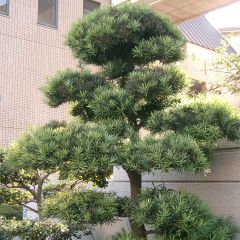
Podocarpus macrophyllus
- Height at maturity 4 m
Groundcover subjects
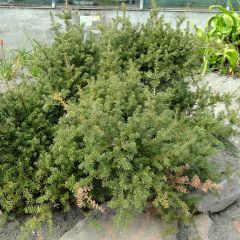
Podocarpus nivalis
- Height at maturity 1,50 m
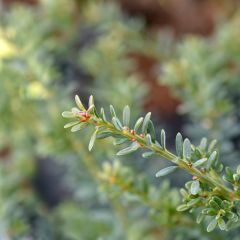
Podocarpus lawrencii Blue Gem
- Height at maturity 1,50 m
Discover other Podocarpus
View all →Available in 1 sizes
Available in 1 sizes
Available in 1 sizes
Available in 1 sizes
Available in 1 sizes
Planting
Where to plant Podocarpus?
The most common Podocarpus thrive well in the Breton climate or that of the British Isles.
Plant Podocarpus macrophyllus in well-drained, cool, fertile, humus-bearing soil, neutral to slightly acidic. Avoid heavy soils that dry out in summer. Choose a spot that is partially shaded, with filtered sunlight, such as in the east, and sheltered from prevailing winds to protect it from extreme temperatures. It has survived -25°C in the British Isles, although its hardiness is rated at -15°C.
Snow Podocarpus (nivalis) accepts poor, cool, not too dry soil, slightly acidic to quite calcareous. However, it is sensitive to heavy, waterlogged soils or those that are too dry in summer and to extreme temperatures. Not very demanding regarding exposure, it adapts to dense shade, partial shade, or full sun.
When to plant?
Podocarpus can be planted from September to November and from February to June.
How to plant?
This plant requires a bit of attention to thrive as it struggles with severe cold, wind, drought, and waterlogged soils. However, it tolerates snow well, at least the nivalis species.
- Soak the root ball well before planting.
- Dig a wide hole at least three times wider than the root ball.
- Add two good shovelfuls of compost to the hole.
- Set the plant level in the planting hole.
- Replace the soil and lightly firm it down.
- Water and mulch.
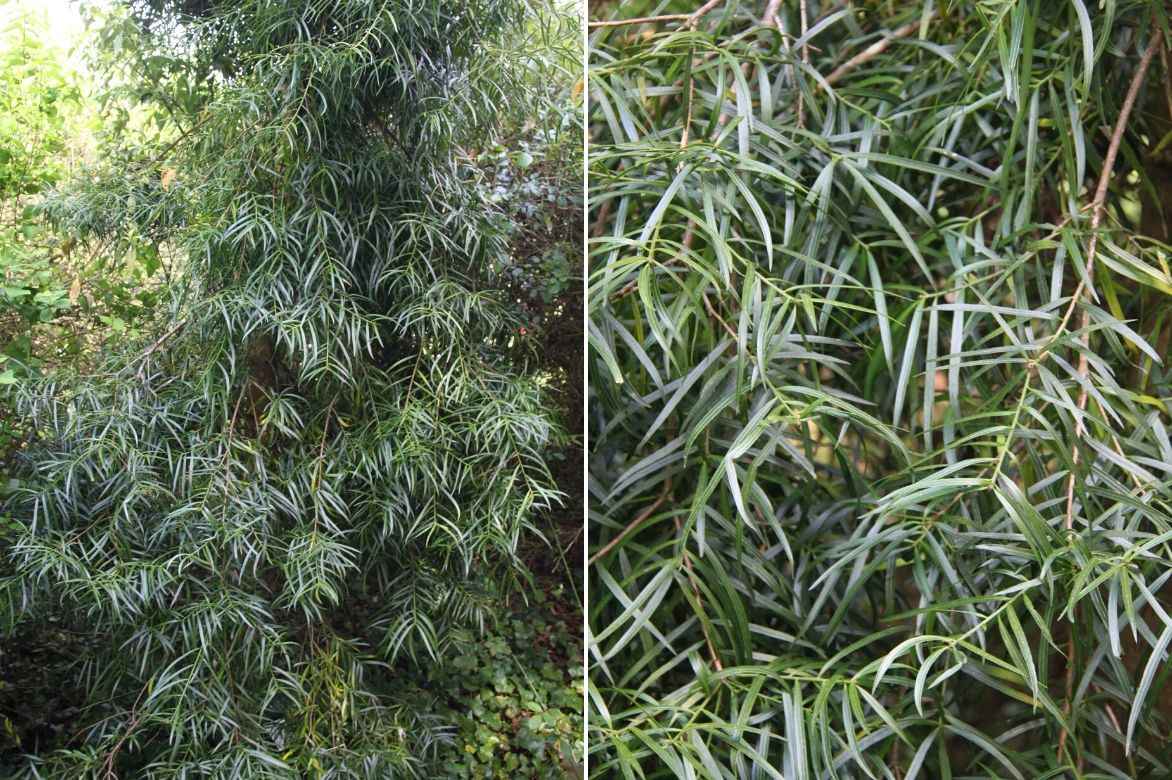 Podocarpus salignus, with willow-like leaves
Podocarpus salignus, with willow-like leaves
Read also
Cloud pruning or niwakiMaintenance and pruning of Podocarpus
- Water generously for the first two or three years, and during prolonged dry spells. Once well established, it will require no watering in summer.
- You can apply a special conifer fertiliser every April, especially for potted specimens.
- Hoe the soil in summer or apply mulch to maintain maximum moisture at the root level.
- These small trees do not need to be pruned, but they tolerate regular pruning at any time of year to form a hedge or a cloud shape. Perform structural pruning in winter. The flexible branches can also be trained against a wall for better protection against the cold.
- If necessary, place your Podocarpus in a cold-protected area in a cool (minimum 10°C) and bright room, or in the house, taking care to mist the foliage. It tends to grow if it lacks light.
- Rarely diseased, ensure it has a well-drained soil to avoid leaf spots, conifer decline, or armillaria. Watch for mealybugs, aphids, and mites (too dry an atmosphere), especially in specimens grown indoors.
Multiplication
The simplest method of propagation is to take cuttings of Podocarpus in August using semi-ripe cuttings. If you have the patience and the opportunity to harvest seeds at ripeness, sow them in February after stratification.
Propagation by cuttings
- Prepare a pot deep by filling it with turf mixed with 50% sand.
- Take tips of branches about 40 cm long and then cut 12 cm cuttings from the area that transitions from brown to green.
- Remove 2/3 of the leaves starting from the base of the cutting.
- Insert these for 2/3 of their length, ensuring they do not touch each other.
- Gently firm the soil around to eliminate air pockets and ensure good contact between the compost and the cutting.
- Place the pot in the shade and out of the wind.
- Keep the cuttings protected from frost during the first winter.
- Transplant your young plants into the ground (or into a larger pot) in the following spring.
Sowing
- Prepare a light substrate and sow the seeds at shallow depth in February.
- Keep the substrate slightly moist until germination.
- Transplant the seedlings when you can handle them into individual pots.
Uses and Associations
Podocarpus macrophyllus makes an excellent subject in a pot, especially when carefully pruned into a cloud shape in a Japanese, contemporary, or even exotic garden. It can be brought indoors, where it finds a familiar atmosphere, away from the scorching rays of the sun.
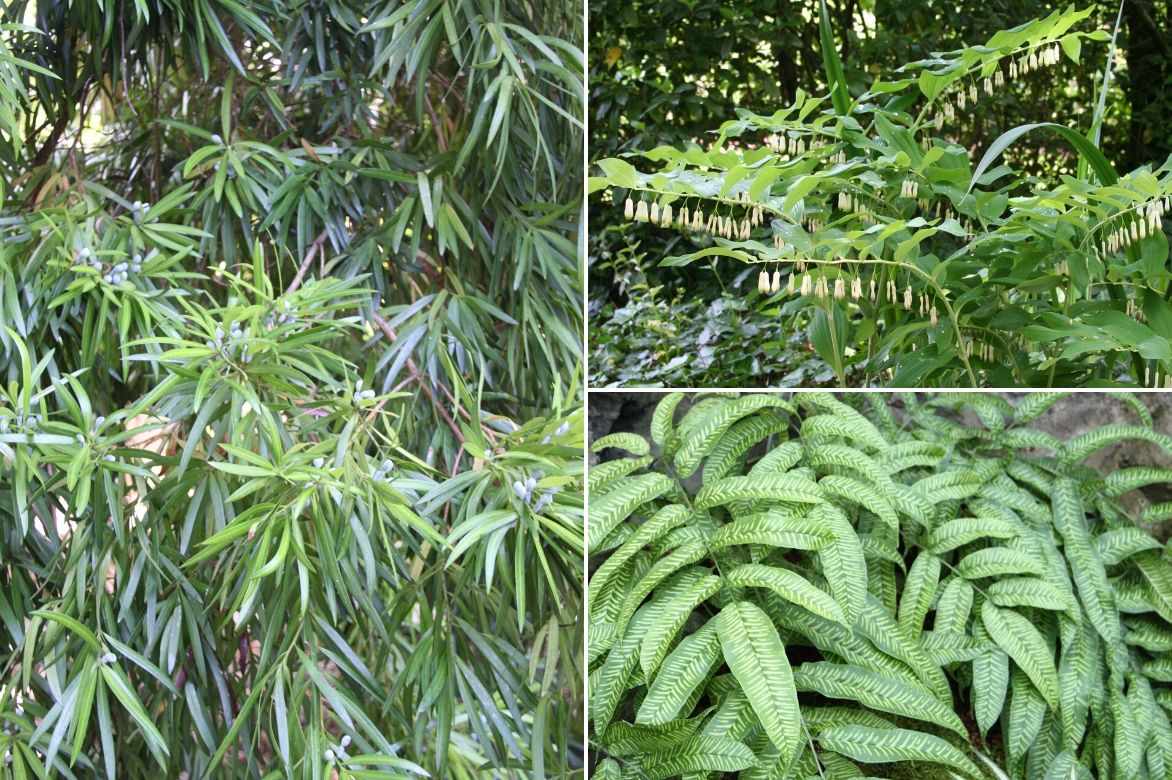
An example of association in partial shade: Podocarpus macrophyllus, Polygonatum multiflorum, and Coniogramme emeiensis
It will also find its place in the garden in a mild, humid, oceanic climate, either in isolation or at the forest edge. Consider its slow growth so it can thrive at its own pace. It can be paired with ericaceous plants such as azaleas and andromedas, or form a well-furnished hedge. It can be combined with grasses, which are very complementary, sacred bamboos (Nandina), or Japanese maples in a large rockery. The graphic qualities of conifers naturally assert themselves in the design of a contemporary garden, which prefers the aesthetics of shapes, silhouettes, and textures over the dance of flowering.
The prostrate forms of Podocarpus, such as P. nivalis, will find their place in a small garden bed or ideally in a rockery, almost anywhere in France. Their natural appearance, akin to the indestructible Microbiota decussata, will integrate well into slightly wild gardens, alongside taller plants like flowering shrubs, which it will help to conceal at the base. They will also thrive when planted in a small free-form hedge or meticulously trimmed to replace boxwood.
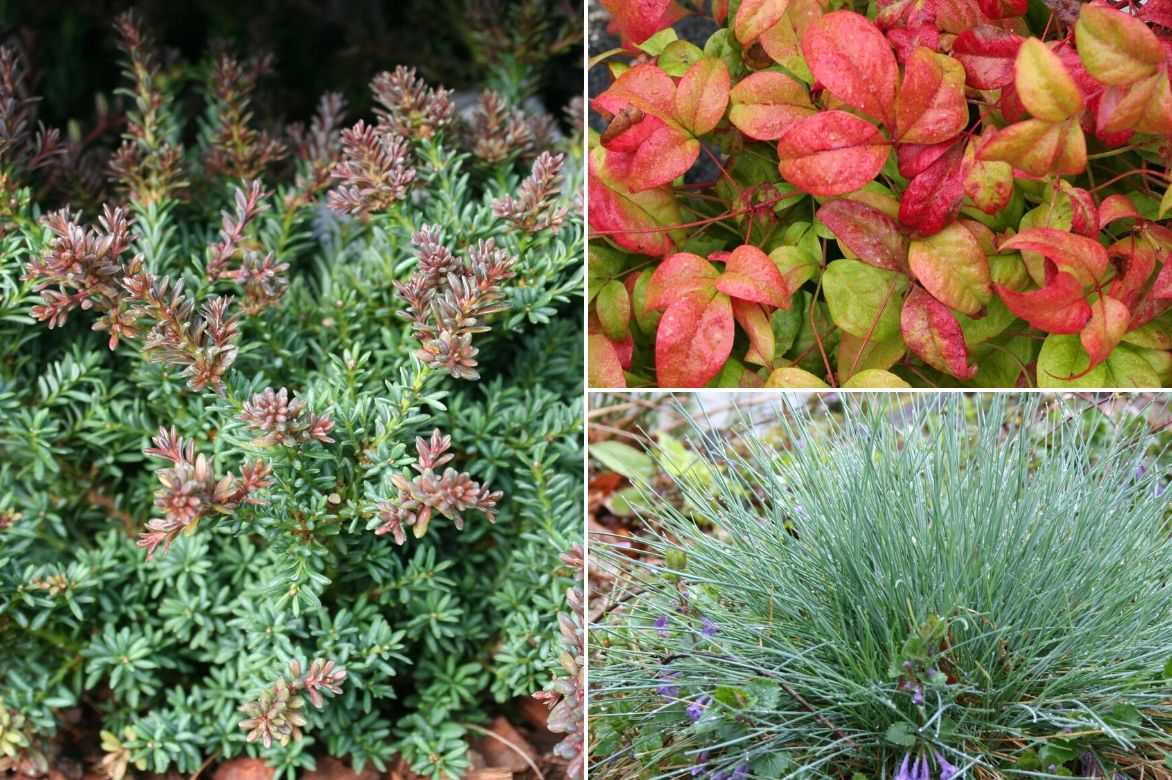
An example of association in full sun: Podocarpus lawrencii ‘Red Tip’ (or ‘Blue Gem’), Nandina domestica, and Festuca glauca ‘Elijah Blue’
These dwarf forms with slow growth will stand out as rare and precious objects in beautiful pottery or as bonsai on the terrace or balcony, allowing them to be sheltered from the harshest winter cold. They harmonise well with large stones, geometric lines, and masonry works.
For further reading
Discover our range of Podocarpus.
Our article: 10 conifers for a South-facing garden
- Subscribe!
- Contents
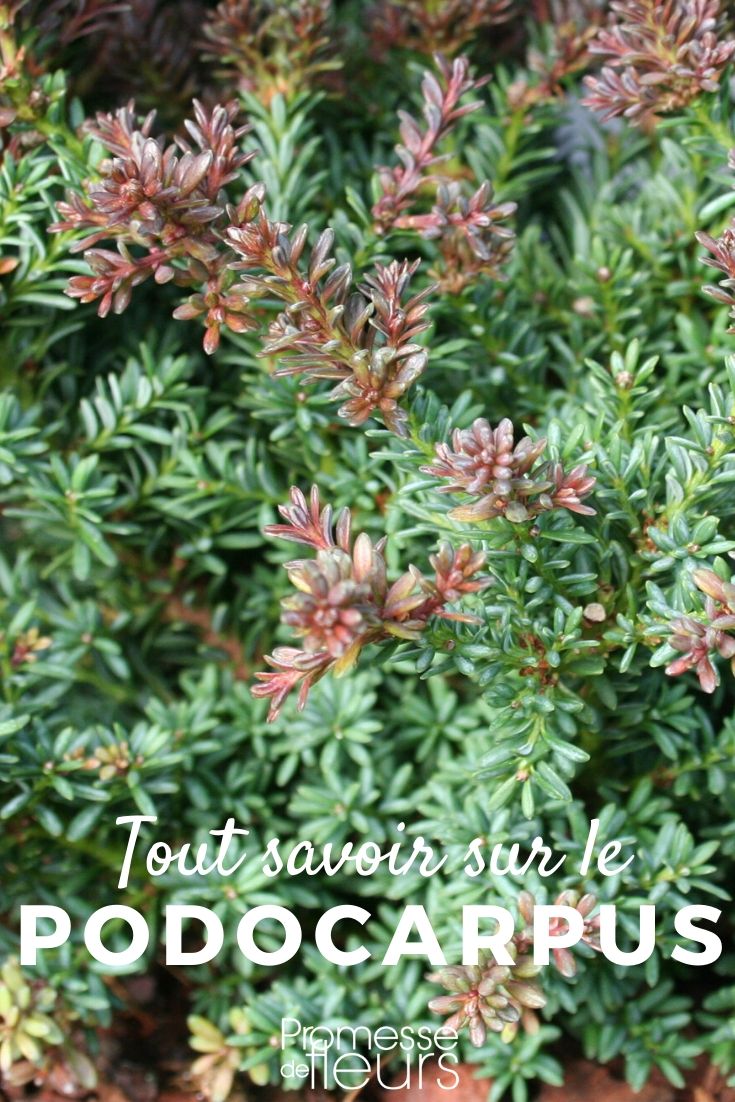
































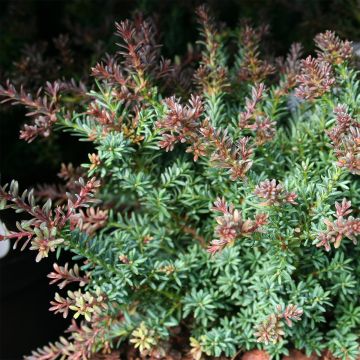
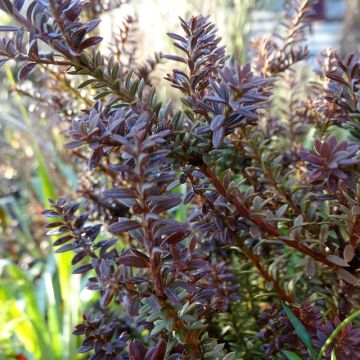



Comments